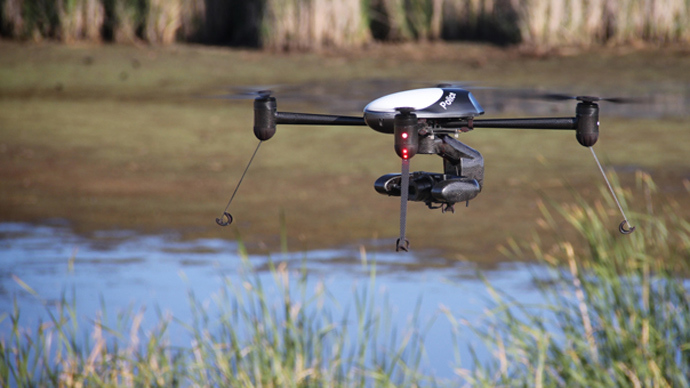North Dakota to start first US drone flights in May

Research drones will begin flying over North Dakota the week of May 5, the Federal Aviation Administration announced Monday. North Dakota is the first of six unmanned aerial systems (UAS) test sites to begin flight operations.
The first flights will take place over North Dakota State University’s Carrington Research Center using a Draganflyer X4ES, the Associated Press reports. A second set of missions will fly over Sullys Hill National Game Preserve this summer. The mission will be run by the North Dakota Department of Commerce. None of the scheduled flights will be over private property.
The aim of these flights will be to show that UAS can check soil quality and the status of crops in precision agriculture research studies, according to an FAA press release. Precision agriculture is a farming management concept that involves fine-tuning the application of seed, fertilizer and pesticide on every square foot of a field to improve yields and reduce costs.
“North Dakota has really taken the lead in supporting the growing unmanned aircraft industry,” Transportation Secretary Anthony Foxx said in a statement. “We look forward to the contributions they and the other test sites will make toward our efforts to ensure the safe and efficient integration of UAS into our nation’s skies.”
Another site, Griffiss International Airport in Rome, NY, will begin flight testing soon after. The New York research center is two-and-a-half months ahead of schedule, the Albany Business Review reports. According to an FAA press release, “Griffiss International plans to work on developing test and evaluation as well as verification and validation processes under FAA safety oversight. The applicant also plans to focus its research on sense and avoid capabilities for UAS and its sites will aid in researching the complexities of integrating UAS into the congested, northeast airspace.”
The four other sites are run by the University of Alaska, which will develop safety standards for UAS operations; the state of Nevada, which will focus on drone operator standards and certification; Texas A&M University’s Corpus Christi campus, which will develop system safety requirements and procedures for airworthiness testing; and Virginia Tech University, which will conduct failure mode testing and evaluate operational and technical risk areas.
The objective of the six sites is to help integrate commercial and research drones into national airspace, which currently only allows for military and law enforcement drones, Fierce Government reports. In 2012, Congress passes a law requiring the FAA develop operational guidelines to integrate UAS into national airspace by the end of 2015.
"We're going to learn a lot as this technology continues to grow at the exponential rates that it has been," FAA Administrator Michael Huerta said at a congressional hearing in January. "We may not be able to provide definitive answers today. What we really need to have is the flexibility that will enable us to figure this out as we go along."
The FAA projects up to 7,500 small commercial drones could be in the air within five years of gaining widespread access to US airspace. Some companies are already counting down until they can use drones commercially. In December, Amazon CEO Jeff Bezos announced his company plans to use ‘octocopter’ mini-drones to deliver goods for US customers – in just 30 minutes.
Japan currently uses unmanned aircraft for seeding and spraying rice, according to UAS maker Yamaha. The United Arab Emirates announced in February it is embarking on a drone project, which, if successful, will see government documents delivered to citizens by unmanned aerial vehicles. This will follow six months of testing.
The FAA chose its six test sites during a rigorous, 10-month process that involved 15 proposals from 24 different states. The agency considered geography, climate location of ground infrastructure, research needs, airspace use, safety, aviation experience and risk, according to its website.














